NIL
NIL in high school? Arizona's next
PHOENIX – In the evolving world of amateur sports, the three-letter acronym NIL has begun rewriting the rulebook.Short for name, image and likeness, this concept has opened the door for monetization at all levels of athletics. A financial revolution once seemingly only available for college athletes is now trickling down all the way to the […]


 PHOENIX – In the evolving world of amateur sports, the three-letter acronym NIL has begun rewriting the rulebook.Short for name, image and likeness, this concept has opened the door for monetization at all levels of athletics. A financial revolution once seemingly only available for college athletes is now trickling down all the way to the high school level. NIL is making its way into high school gymnasiums and fields with athletes across the U.S. growing their brand before stepping foot on a college campus.At the center of this shift in Phoenix is Zaire “Cherri” Hatter, a 14-year-old basketball star from Desert Vista High School who has already begun navigating the life of a high-profile athlete. Hatter is a representation of the new world of youth athletics – a world where Hatter can reach new heights while staying true to herself.It’s terrain University of Arizona basketball player Jada Williams knows well. She was among the first female high school basketball players to sign a national NIL deal when she was at La Jolla Country Day School in San Diego and continues to reap the financial benefits from companies including Spalding and Gym Shark.How we got hereTo better understand NIL’s rapid growth, we have to look back to the origin. At the start, collegiate athletes competed for either pride or scholarships. But as collegiate sports evolved into a multi billion-dollar industry over time, the model began to shift.Need a break? Play the USA TODAY Daily Crossword Puzzle.
PHOENIX – In the evolving world of amateur sports, the three-letter acronym NIL has begun rewriting the rulebook.Short for name, image and likeness, this concept has opened the door for monetization at all levels of athletics. A financial revolution once seemingly only available for college athletes is now trickling down all the way to the high school level. NIL is making its way into high school gymnasiums and fields with athletes across the U.S. growing their brand before stepping foot on a college campus.At the center of this shift in Phoenix is Zaire “Cherri” Hatter, a 14-year-old basketball star from Desert Vista High School who has already begun navigating the life of a high-profile athlete. Hatter is a representation of the new world of youth athletics – a world where Hatter can reach new heights while staying true to herself.It’s terrain University of Arizona basketball player Jada Williams knows well. She was among the first female high school basketball players to sign a national NIL deal when she was at La Jolla Country Day School in San Diego and continues to reap the financial benefits from companies including Spalding and Gym Shark.How we got hereTo better understand NIL’s rapid growth, we have to look back to the origin. At the start, collegiate athletes competed for either pride or scholarships. But as collegiate sports evolved into a multi billion-dollar industry over time, the model began to shift.Need a break? Play the USA TODAY Daily Crossword Puzzle.
In 2021, after years of legal battles among athletes and the courts, a landmark Supreme Court decision came in the NCAA vs. Alston case. As a result, the NCAA adjusted its rules to allow athletes to receive compensation through NIL deals.One level lower, discussions began around NIL and high school athletes. As of 2025, at least 42 states and the District of Columbia allow high school athletes to profit from NIL.Jon Kappes, an associate research professor at Arizona State’s Sandra Day O’Connor College of Law who recently hosted an event about NIL for young athletes, spoke to this and some of the risks that deals can pose in states where NIL is not permitted.“I am aware that different states have been slower to change the high school policies, which have in some instances said high school students can lose eligibility,” Kappes said.The Arizona Interscholastic Association officially approved NIL activity for high school students, allowing students the ability to profit under strict guidelines. Arizona’s high school students are prohibited from wearing school uniforms or logos or have any affiliation to the school in any NIL activities.“It has added another layer of support and education we need to make sure we address these student-athletes, we have to make sure they are aware of the AIA bylaws,” said Jared Walther, the assistant principal of activities at Desert Vista. “We educate our coaches with the bylaws and help them navigate it with the kids.”The support systemHatter’s emergence as one of the top high school athletes, and the top girls state basketball athlete in the class of 2028 has placed the freshman guard at the forefront of the Arizona NIL youth movement. Hatter is already in line for NIL opportunities while also fielding Division I offers from programs like Alabama and Maryland. She recalled her excitement when she received that first offer.“It was exciting, because it confirms that my hard work has paid off so far,” Hatter said. “I definitely still have a lot of work to keep getting better.”While she enjoys the spotlight at a young age, Hatter is fully aware of the responsibility that comes with being a high-level athlete. The pressure of living up to the hype comes with its own challenges, but she keeps her mind focused.“I still have three years left of high school, I am making sure I continue to get better each day,” Hatter said.Maintaining a positive mindset on and off the court at times can be tricky and hard to manage for young athletes. Having her mother by her side has been one of the keys in her success so far.With her mother working as an equipment manager for the Desert Vista team, the long afternoon sessions that extend into the evenings become easier with her mother’s sacrifices.
“It is a big time commitment, but I enjoy the process of juggling school, and basketball,” Hatter said.
Another piece of the puzzle is Desert Vista coach Erin O’Bryan, a former university of Arizona women’s basketball player, who understands Hatter is rare and provides guidance based on her own experiences.
“Cherri’s work ethic is unmatched, she puts in hours upon hours in the weight room, on the court, and in the training room. She is dedicated to becoming the best player she can,” O’Bryan said. “Cherri has a very high ceiling, and she has high expectations for herself. She could end up being the most highly sought after player in Arizona.”The praise is consistent among all coaches, friends and family, but the admiration does not change Hatter’s personality. O’Bryan mentioned that the era of NIL has not changed any team dynamics.Hatter’s acknowledgment extends beyond just the court for Walther, who sees how well she handles the pressure at her age.“For being only a freshman and having these expectations placed on her, she has gone with the flow and not let any of it disrupt her usual day to day life,” Walther said. “She continues to do well in the classroom even with her basketball responsibilities.”Beyond the courtThe pressure of NIL reaches beyond just the financial aspects and collegiate recruitments – they also influence mental health. The feeling of starting early and standing out can at times train kids to not only train to like professionals but seemingly market themselves like that as well.Lindsey Markwell, a lecturer at Arizona State University in the Movement Sciences Programs with expertise in sport psychology and mental performance, echoes those concerns.“When sport becomes the only thing a youth athlete does or the only thing others talk to them about it can lead to single-performance based identity,” Markwell said. “Their self-worth becomes tied to how well they perform.”In most cases, especially in Arizona, sports such as basketball are year-round due to school commitments and club or team commitments resulting in a situation where most do not get that break or that “offseason” away.In Hatter’s case, it is vital to her success to have a strong environment surrounding her to ensure the road trips or the early practices are possible, and the enjoyment of being a kid isn’t lost.Luckily for Hatter that is exactly what she has from her mom by her side, to her sister, to all coaches and teachers, everyone in Hatter life is there to support her and see her grow not just as an athlete but as a person.While the mental load for anyone at this age let alone a teenager is quite a lot, it is simply hard to put NIL or competitive sports at fault. For all athletes alike, positive mental health outcomes will always be possible when someone such as Hatter has the ability to be heard and feel valued past how they play on a given day.“When supported well, early commitment can build resilience, discipline, and confidence,” Markwell said. “Balance, autonomy, and having a voice in their schedule makes all the difference.”For Desert Vista girls basketball the show is not all just about Hatter instead she is the beacon that shines brightest for the team and inspires each person to give it their best. Ultimately, by serving as leader on the court, Hatter’s passion and love for the game echoes across the locker room and classroom.“Cherri gives our team confidence, she is reliable and plays well every time she steps on the court,” O’Bryan said. “She upholds the culture of toughness and winning.”A quick comparisonAs the spotlight continues to grow on young athletes such as Hatter, it is brought to question that what we’re witnessing isn’t entirely new – it just looks different. NIL, with the branding and pressure to perform mirrors some of the experience of the youth entertainment culture of child stars in Hollywood.“In terms of an age threshold, what comes to my mind is that this context of athletics and sports is not that different from young actors,” Kappes said. “So you’ve got child actors that are toddlers, that are babies, nine months old, two years old.”Like child actors, NIL athletes tend to be thrusted into adult conversations and spaces while still developing as a person mentally and emotionally. In a lot of situations they are learning to market themselves and perform under pressure before they can even legally drive a car.“Athletes are branding themselves at 14 or 15, constantly curating how they’re seen,” Markwell said. “That pressure to always perform – both in real life and online – is a lot for anyone, let alone a teenager.”Though unlike child stars in Hollywood, students like Hatter are expected to attend school, take tests and homework like everyone else and in some situations to a higher degree.When hearing from people close to her though, this is exactly what makes Hatter special — managing both lives – as a freshmen student and a high profile athlete. She is able to thrive as a person in the classroom and on the court.A new eraThe NIL era has unlocked untapped doors for young athletes to offer opportunities to profit from not only themselves but their passions. As time moves on, expectation starts to grow and the pressure to perform is more than just sport.“The first thing for a young person to look at: Do they want to be engaged in sanctioned high school athletics, or do they not,” Kappes said.

NIL
Oklahoma State VP and Athletics Director Chad Weiberg Announces Revenue Sharing Sports
STILLWATER – Oklahoma State University President Dr. James Hess and vice president and athletics director Chad Weiberg were at Oklahoma State University-OKC for the final OSU/A&M Board of Regents meeting for the fiscal year. Part of the meeting had Weiberg advising the regents that Oklahoma State, in accordance with the House vs. NCAA settlement approval […]
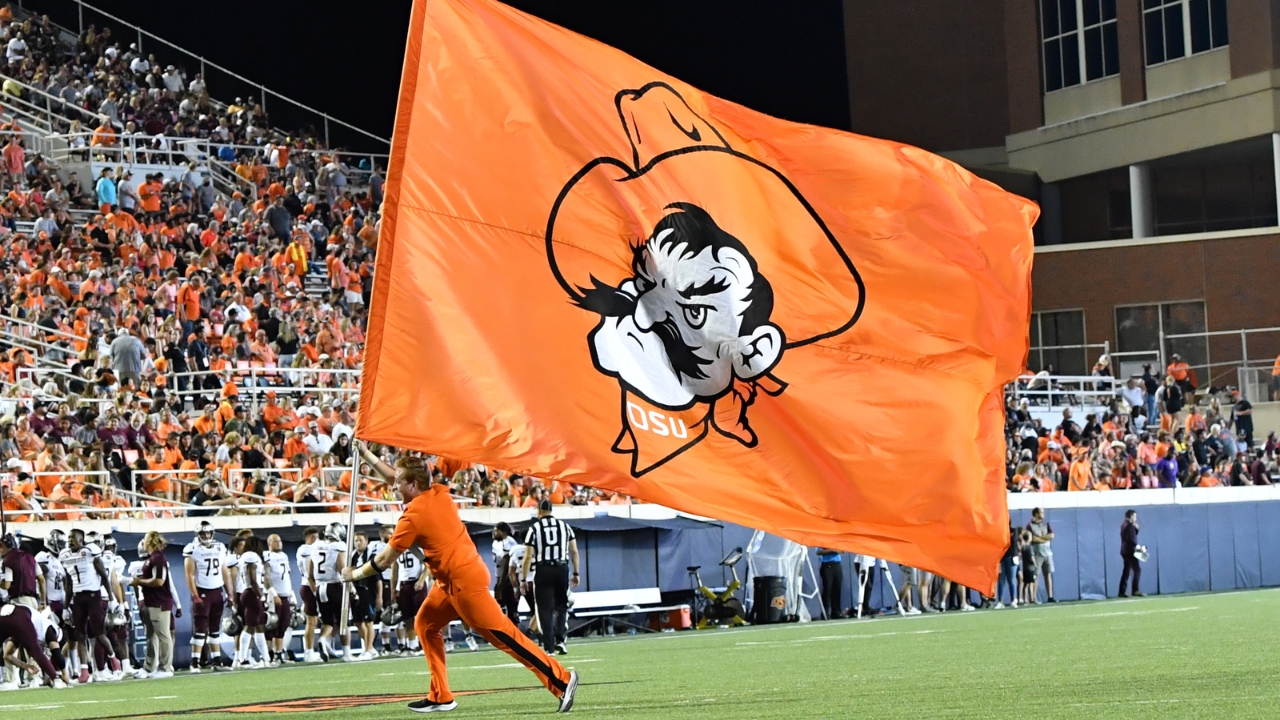
STILLWATER – Oklahoma State University President Dr. James Hess and vice president and athletics director Chad Weiberg were at Oklahoma State University-OKC for the final OSU/A&M Board of Regents meeting for the fiscal year. Part of the meeting had Weiberg advising the regents that Oklahoma State, in accordance with the House vs. NCAA settlement approval and the start of the new fiscal year on July 1, would pay revenue sharing to student-athletes in their seven ticketed sports. Those are football, men’s basketball, women’s basketball, wrestling, women’s soccer, softball, and baseball. Weiberg’s social media mesaage said other sports would get additional scholarship funding. The House vs. NCAA settlement and the corresponding decisions have the total amount that schools will pay athletes at $20.5 million.
Again, the most critical part of all this is not what sports will be included, but what the financial split will be. Most Power Conference schools are pushing 70-75 percent of the annual total to football. At most schools it is the major revenue producer and the sport that foot most of the bill for athletics. Generally, men’s basketball gets 10-15 percent, then any others share in the remaining 10-20 percent of the total.

Jerod Hill/OSU Athletics
Cowboy football will get the biggest percentage or revenue share, but how much?
Oklahoma State football head coach Mike Gundy and his staff as well as men’s basketball head coach Steve Lutz and his staff were heavily invested in the NCAA transfer portal in making over the rosters in their programs. That can be costly.
NIL will continue and will be critical in other sports not included in revenue sharing, but any NIL deal valued over $600 to the student-athlete will be reviewed by the new College Sports Commission and their software assist program NIL-Go. The power conferences including the Big 12 have agreed to abide by the CSC decisions.

Robert Allen – Pokes Report
Chad Weiberg
The regents won’t meet again until September, so gauging from what was done on Thursday with the University of Oklahoma Board of Regents and the announcement of the sports that OU would engage in revenue sharing, it made sense Oklahoma State would advise their regents. The action did not need regents approval.
Some schools like Georgia and Baylor have gone public with the percentages they are paying major sports, but I wouldn’t hold my breath on getting that from Oklahoma State. Honestly, they shouldn’t announce that and they should do all they can to keep individual student-athlete “salaries” secret. That really is proprietory information that you don’t want in the hands of your rivals.
NIL
Urban Meyer Says Big Ten’s Passed SEC, Small Schools Will Be ‘Feeder’ Programs
The Big Ten’s recent success at the top could push it past other top conferences PublishedJune 13, 2025 7:07 PM EDT•UpdatedJune 13, 2025 7:07 PM EDT Facebook Twitter Email Copy Link Urban Meyer has better perspective than almost anyone on the differences and divide between smaller, Group of Five schools and power programs. From head […]

The Big Ten’s recent success at the top could push it past other top conferences
Urban Meyer has better perspective than almost anyone on the differences and divide between smaller, Group of Five schools and power programs. From head coaching positions at Bowling Green and Utah, to then Florida, the NFL and back to Ohio State University, Meyer’s done it all.
So when he talks about the future of the college football landscape, it’s worth listening.
Meyer earlier this week discussed his concerns over the distribution of talent on “The Triple Option” podcast with Mark Ingram and Rob Stone. Specifically, that developing talent at smaller schools won’t pay the same dividends as it did when he was coaching.
READ: Urban Meyer Roasts Lincoln Riley At USC, Forgets Recent Ohio State History
“They become the feeder system for the big boys,” he explained. “It’s still beautiful football. The MAC, I coached there for two years, it’s fantastic because everybody had the same players. So it was really a coaches league. Some leagues you have the best teams are so much better than the other teams. But what happens (now) … the reality is you’re going to develop a player and he’s going to leave.”
It’s hard to argue.
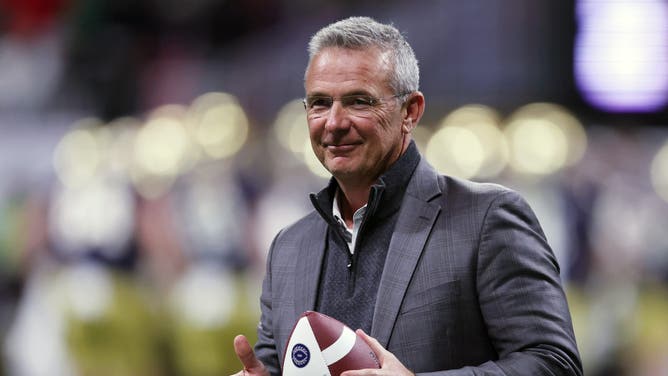
Jan 20, 2025; Atlanta, GA, USA; Urban Meyer looks on during the second half the CFP National Championship college football game at Mercedes-Benz Stadium. Mandatory Credit: Brett Davis-Imagn Images
Urban Meyer Talks Big Ten, SEC Rivalry
The NIL era has created the “feeder” system, where small programs now serve as an effective minor league program for bigger teams.
If say, a Bowling Green type program recruits well, finds a promising high schooler, develops him as a freshman and/or sophomore, it’s now become a near certainty that an Alabama, USC, or Michigan will come calling soon afterward. Unrestricted transfers have it easier for players to find better financial opportunities and more national television exposure.
And it’s hard to argue against players taking those opportunities. After all, any student or employee would jump at the chance to improve their financial or career prospects if available.
Meyer wasn’t done there.
In a second interview, part of the “Another Dooley Noted” Podcast, Meyer said he thinks the Big Ten Conference has passed the SEC in terms of top-flight quality.
“Well, you know what the SEC’s done? It’s raised the level,” he explained. “But the Big Ten has passed the SEC at the upper part. If you would have told me that 10 years ago, I would have said it’s not even close.”
The Big Ten has won the last two National Championships, something Meyer didn’t believe was possible when he started coaching in Columbus.
“When I first got to the Big Ten, even Shelley said, ‘What in the world? This is a slow man’s game up here,’ and I like to think that the Buckeyes really changed that. Then everyone else started investing in their schools,” Meyer said. “And started recruiting the best player, not just the footprint. As a result, the Wolverine team two years ago was one of the best teams I’ve seen. The Buckeyes team this year is one of the best I’ve ever seen. You’re seeing Penn State, and some of these teams have great success.”
There’s no arguing that the Big Ten has closed the gap, but SEC fans will say it’s going to take more than two years, and more teams will have to show they’re legitimate contenders before they’ve fully become the best conference. Not to mention that the SEC’s depth is unique, even among Power 5 conferences.
How will Michigan, Ohio State, Penn State, Oregon and USC stack up this season against Alabama, Georgia, Texas, Ole Miss and South Carolina? The answer to that question will go a long way towards proving Meyer right. Or wrong.
NIL
College World Series: How blue blood Oregon State overcame Pac-12 collapse to return to Omaha as independent
It was never going to be easy. The Oregon State baseball program — despite its status as a blue blood and arguably the top operation in the sport this century — faced an uphill battle from the moment the Pac-12 collapsed. When the Beavers stared elimination in the eyes five times this postseason, they were […]

It was never going to be easy. The Oregon State baseball program — despite its status as a blue blood and arguably the top operation in the sport this century — faced an uphill battle from the moment the Pac-12 collapsed. When the Beavers stared elimination in the eyes five times this postseason, they were no strangers to adversity. Right at home with their backs against the wall, they rattled off victories in each of those do-or-die contests to punch their ticket to Omaha.
Superheroes. That’s what coach Mitch Canham called his players ahead of their opening game at the 2025 College World Series.
“I really want more of the story to be out,” Canham said. “I don’t want walls around our clubhouse. I would like just pillars so people can see in and understand what they went through in its entirety this year and how special it really is. That was the prayer from the get go: Let’s make this thing so challenging. Let’s do something that no one else has ever done.
“That gives them the opportunity to go out there and transform college athletics.”
Oregon State goes independent
The grueling road back to Omaha began well before Nelson Keljo threw the first pitch on Valentine’s Day. The opening chapter in this team’s story hit the paper in the summer of 2023 when eight schools, following USC and UCLA from the year prior, announced their intentions to depart from the Pac-12.
Only Oregon State and Washington State went homeless in the landscape-altering wave of conference realignment. Both universities patched together plans for the two-year grace period in which they control the Pac-12’s assets and continue to rebuild the league. For baseball purposes, the Cougars packed their bags for the Mountain West as temporary members. The Beavers paved their own path and became the only Division I Independent for the 2025 season.
 Independents to reach NCAA Tournament since 2000
Independents to reach NCAA Tournament since 2000
|
2025 |
Oregon State |
TBD |
|
2012 |
Dallas Baptist |
Lost in regional |
|
2004 |
Miami |
Reached CWS |
|
2003 |
Miami |
Reached CWS |
|
2001 |
Miami |
Won national championship |
Going conference-less in an era of college athletics where media rights deals reign supreme, leagues boast as many as 18 teams and the chasm between the haves and have-nots only continues to widen was a major risk, yet it paid off.
Transfer portal ravages the Beavers
The transfer portal gutted Oregon State’s athletic department following the Pac-12’s demise. Football and women’s basketball were among the hardest hit, and their results last season plummeted. The football team’s win percentage dropped from 61.5% to 41.7%. Women’s basketball miraculously returned to the NCAA Tournament but did so at just over .500 on the year.
The Oregon State baseball brand was so strong, however, that Canham used the portal to his advantage rather than his detriment and built a roster that posted a better record than the 2024 squad. In from Washington came shortstop Aiva Arquette, who turned down larger NIL packages because, in his words, he wanted to win. The projected first-round MLB Draft pick has been the best bat in the lineup and is a walking highlight reel defensively.
2025 MLB Draft rankings: Top 30 players in class, including Eli Willits, Jamie Arnold, Ethan Holliday and more
R.J. Anderson

Perhaps most importantly, Canham convinced nearly all of his most important players from a year ago to stick around rather than look for a new program, star outfielder Gavin Turley and stalwart catcher Wilson Weber chief among them.
“One of the biggest things I want to point out is with all of this going on with NIL, transfer portal, the amount of money that can be had in the draft, you name it, these guys all chose to be at Oregon State,” Canham said. “That means a lot about who they are as men and where their values lay, how much they care about that place and that brotherhood. It warms my heart that I get to go be a part of that.”
Beavers attack brutal, road-heavy schedule
In an anecdote that defines Oregon State’s struggle the last two seasons, players and coaches recall earlier this season when the team bus never showed up on travel day. Players and coaches scrambled to find enough cars to drive themselves nearly two hours north to the Portland International Airport for one of their countless road series.
By the end of the regular season, the games they played on that trip accounted for some of the 35 for which they suited up away from Goss Stadium at Coleman Field. The Beavers held just 19 games, in contrast, at the nation’s oldest continuous ballpark before the start of regional play.
“I’ve been saying it all year,” said Freshman All-American starting pitcher Dax Whitney, who is set to take the mound in Friday’s College World Series opener. “I think we’re more prepared than anybody to go do this thing. We’ve been handling adversity all year, and we welcome it all the time. I think we’re better trained than anybody in the country to go do this thing.”
Oregon State’s strength of schedule ranks No. 33 nationally, per D1Baseball. That is not too shabby for a program that did not have the luxury of playing consistent weekend series against power conference competition. Road battles with tournament-caliber opposition and a couple of preseason events with premier programs boosted the résumé and ensured the Beavers got enough tests in before postseason play. But it was a drag.
At one point, the Beavers even reached a mutual agreement with Portland to cancel one of their midweek matchups due to the scheduling demands. Canham’s team had just arrived back on the mainland from a four-game swing at Hawai’i when it was scheduled tens of hours later to depart for a neutral-site battle against Iowa in Des Moines. Rather than play eight games in 10 days, Oregon State took a much-needed breather.
It worked wonders, as they won the first two games against the Hawkeyes and tied the last, shoring up a top-eight national seed in the process and guaranteeing home-field advantage through the super regional round.
Long wait for home games pays off
While teams across the nation competed in their conference tournaments, Oregon State held a three-day fan appreciation weekend of sorts with open scrimmages, autograph sessions and even a community movie night. Accustomed to their constant trips up and down Interstate 5 to the PDX airport and night after night in hotel rooms, the Beavers suddenly found themselves in the early stages of an extended home stand.
Only once in the regular season did Oregon State play more than four straight games at home. Opponents simply would not make the trek to Corvallis to play in one of college baseball’s most intimidating parks. The NCAA sent four squads to the home of the three-time national champions for regional play, though, and another in the super regional round. The Beavers strung together eight consecutive games in their home digs.
Program legends Jacoby Ellsbury, Darwin Barney and Nick Madrigal were among those on hand over the last two weekends. Football coach Trent Bray was a ringleader of the constant chants and rhythmic clapping that echoed throughout the legendary grounds, nestled between campus buildings and an old railroad line. Record crowds packed both permanent and temporary seats on a daily basis as Oregon State inched closer to the College World Series.
“I’ve had a lot of other coaches come in and go, ‘Wow, it’s really like this out here, huh?'” said Canham. “Hearing coaches that are coming from the East Coast. Butch Thompson said that when he came in a couple years ago. Link (Jarrett) said it when he was here. ‘Wow, this place is pretty special.’ There’s no doubt about it. That’s why I wish everyone could live it for a little bit of time.”
The Beavers played the maximum number of games across the Corvallis Regional and Super Regional, needing to bounce back from a loss in the regional opener and a defeat in Game 2 of the super regional series with Florida State. They won the ones that mattered most, like they did in 2006 and 2018 when they became one of just two teams this century to lose their College World Series opener and proceed to win the national championship.
It is almost as if Oregon State is most comfortable when the adversity is at its strongest. There is a good chance it will strike again in the final stanza of the Beavers’ hunt for national championship No. 4.
Frankly, they wouldn’t have it any other way.
NIL
Kentucky exploring adding Entertainment District near Kroger Field
Could an entertainment district be coming soon to Kentucky’s campus? The university is at least going to explore the idea as it looks for ways to grow revenue in the new age of college athletics. At yesterday’s UK Board of Trustees meeting, UK Athletics submitted a request for information (RFI) to develop an entertainment district […]
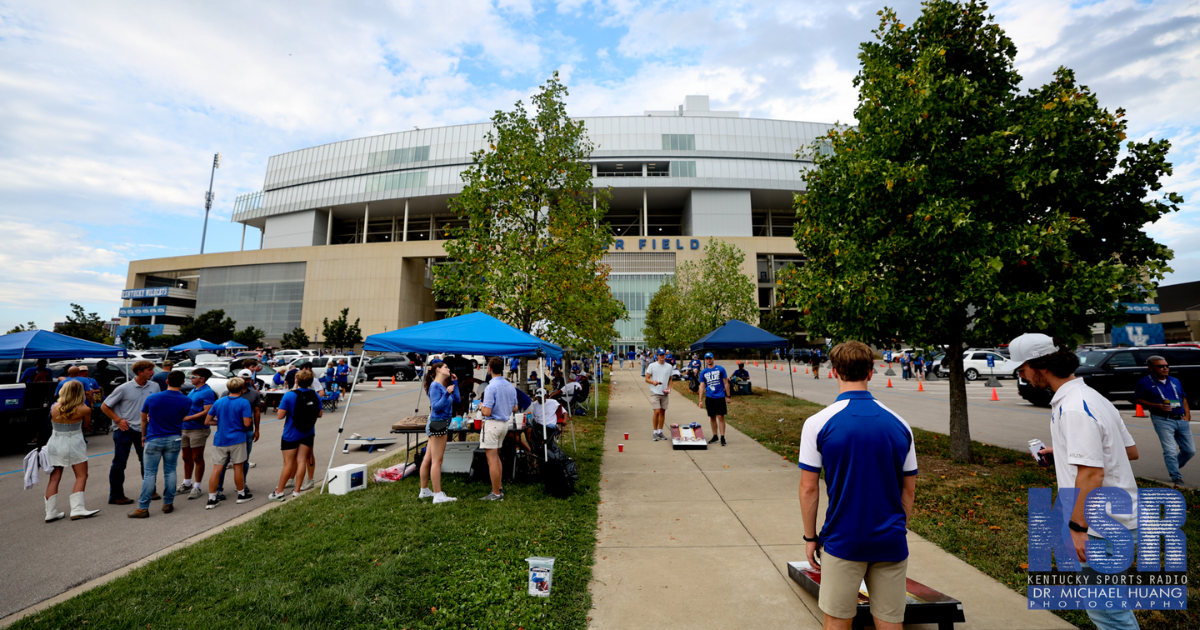
Could an entertainment district be coming soon to Kentucky’s campus? The university is at least going to explore the idea as it looks for ways to grow revenue in the new age of college athletics.
At yesterday’s UK Board of Trustees meeting, UK Athletics submitted a request for information (RFI) to develop an entertainment district on campus, which could include concepts such as restaurants, hotels, and other entertainment options. The request was part of a larger proposal for $110 million worth of investments over the next few years, which was approved today by the Board of Trustees. Although a location was not mentioned in the presentation, the district would presumably be on the south side of campus, adjacent to Kroger Field, Kentucky Proud Park, the Wendell & Vickie Bell Soccer Complex, and John Cropp Stadium.
Athletics director Mitch Barnhart told BBN Tonight’s Maggie Davis that the entertainment district, or “fan zone,” as he called it, would be similar to those in professional sports cities. He specifically mentioned the Deer District outside the Fiserv Forum, which he and Kentucky fans who made the trip to Milwaukee got a firsthand look at during the first and second rounds of the NCAA Tournament in March. The Deer District is an indoor-outdoor sports, retail, and entertainment hub built on 30 acres, at the center of which is a large plaza, where, in 2021, 65,000 fans gathered to watch the Bucks’ NBA Championship run. The district includes several bars, restaurants, shops, and even an outdoor beer garden. As someone who went there more than once during that weekend, it’s pretty awesome.


Other schools have already announced plans for entertainment districts near their football stadiums, most notably Tennessee. The 175,000 square foot Neyland Entertainment District will include a 240-room hotel with 60 additional condos, retail, restaurants (including one with a rooftop), a conference center, and a pool with a terrace. The area will tie together Neyland Stadium and Food City Center. Kansas is also building the Gateway District, a new entertainment and lodging district surrounding Memorial Stadium.
Where exactly would Kentucky’s entertainment district be located? There are some intriguing options around Kroger Field. That could further cut into the tailgating areas; however, now that schools can distribute up to $20.5 million to their athletes this upcoming year (and increasingly more in the years after that), Kentucky needs all the money it can get. That’s the primary reason that over the next year, UK Athletics will transition to Champions Blue LLC, a non-profit holding company designed to give the department more flexibility to unlock new revenue streams through public-private partnerships and potentially other transactions, such as real estate. Maybe that real estate includes more property around the stadium for the entertainment district?
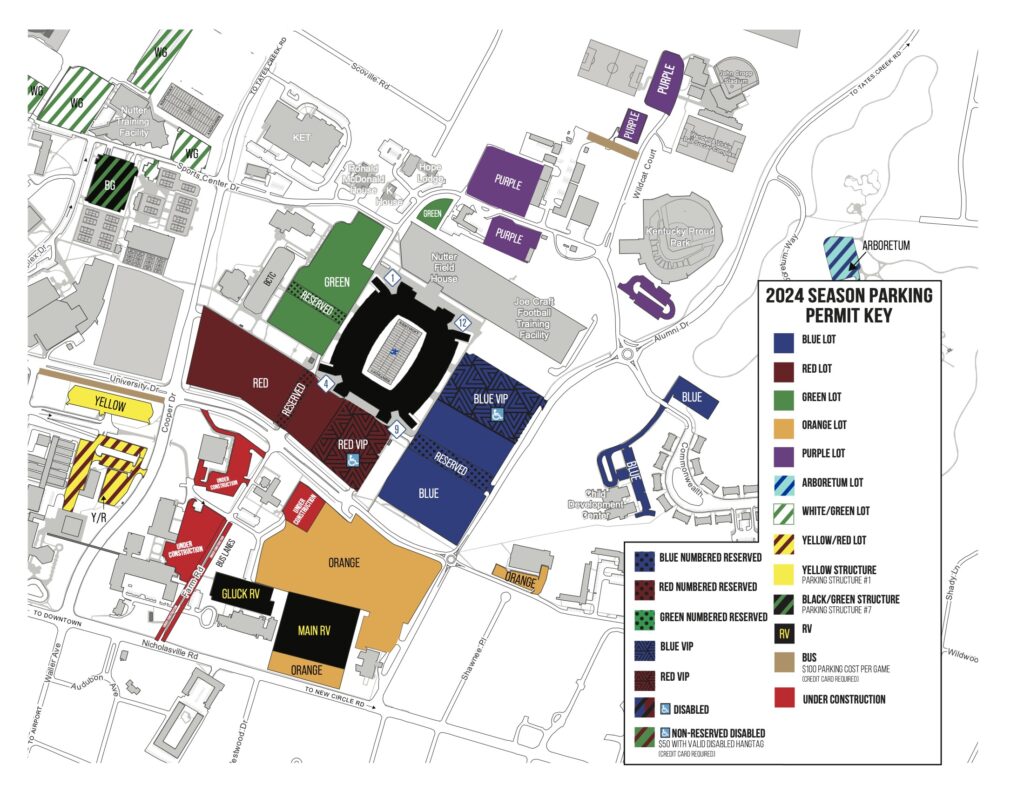
Now that the request for information has been submitted, UK can start exploring some options. As much as we all love tailgating, UK is only making money off parking passes and the REVELxp VIP tailgate setups (which I can’t imagine have been selling like hotcakes). Creating a new area near Kroger Field where fans can eat, drink, and even stay, with the athletic department getting a piece of the pie through partnerships, is just smart.
Imagine having a hotel room right next to the stadium on a big gameday, or even during basketball season, the district being used for watch parties for away games and the SEC and NCAA Tournaments. It would be awesome.
Renovations coming to Kroger Field
Another part of the $110 million investment is $36 million for Kroger Field. Thirteen million of that will go toward maintenance, $18 million for renovations to the corner suites, and $8 million for the initial design of a West End Zone Club space and wi-fi improvements.
“Obviously, you have to continue to maintain and repair the stadium,” Barnhart told Maggie Davis. “For safety reasons, making sure that all the components, the stairwells, ramps, those kinds of things, that there’s not anything that’s going to put our patrons at risk, so that’s important.
“The other piece is just the fan amenities that allow us to bring new revenue streams, to be able to do some things differently in our suites, really, really important. Those are priorities. What things, what decisions do we make that allow us to create revenue streams or be more efficient, or make sure that we’re prioritizing our fan experiences the right way?”
UK Athletics also requested $5 million for renovations to the soccer and softball facilities. Kentucky will host the SEC Softball Tournament in 2026.
NIL
Chris Petersen talks Shedeur, NIL & the future of College Football
THE HERD WITH COLIN COWHERD Trending MLB NFL Gold Cup UFL INDYCAR NASCAR LIV NBA NHL PGA NCAAFB 1
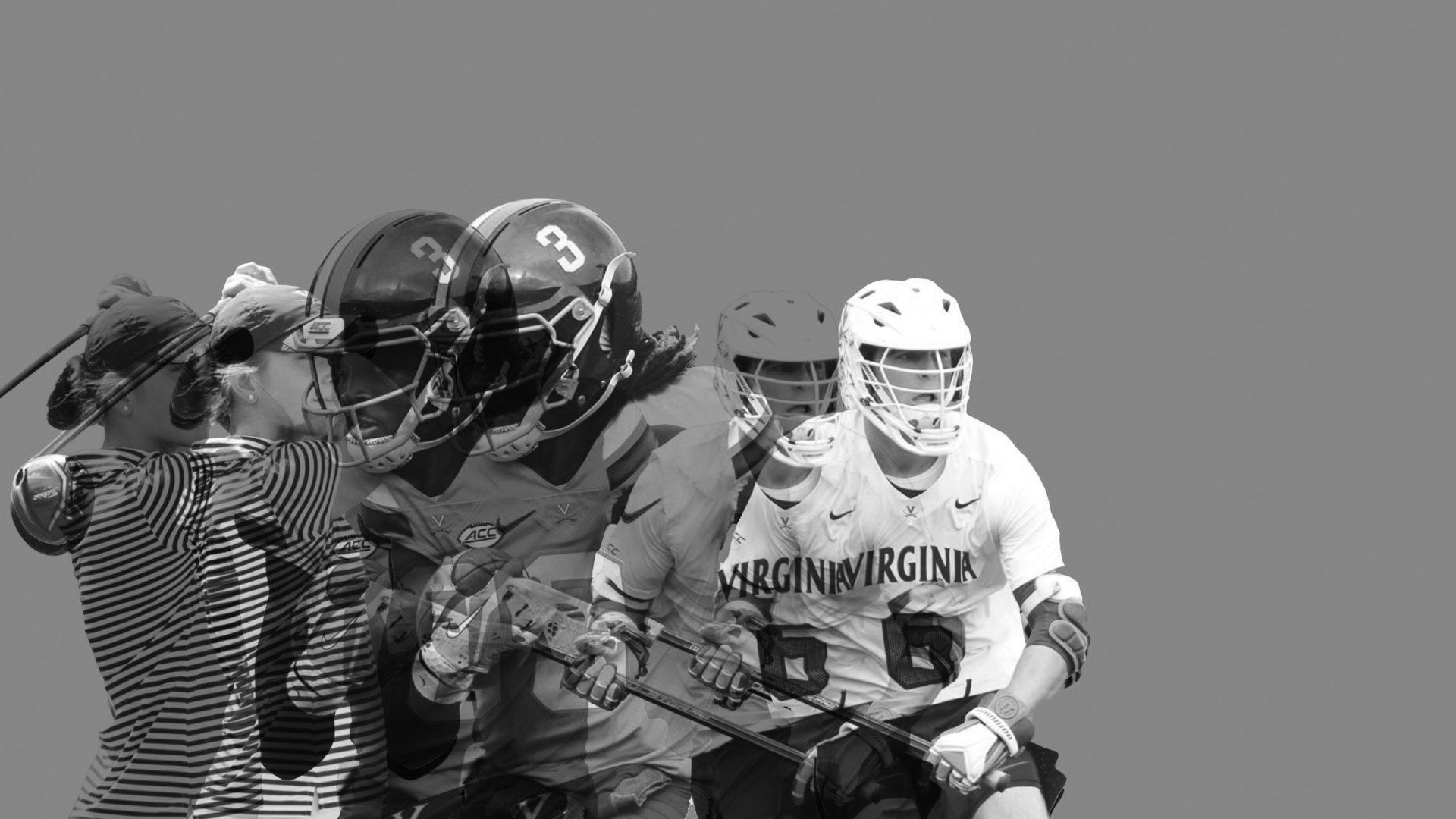
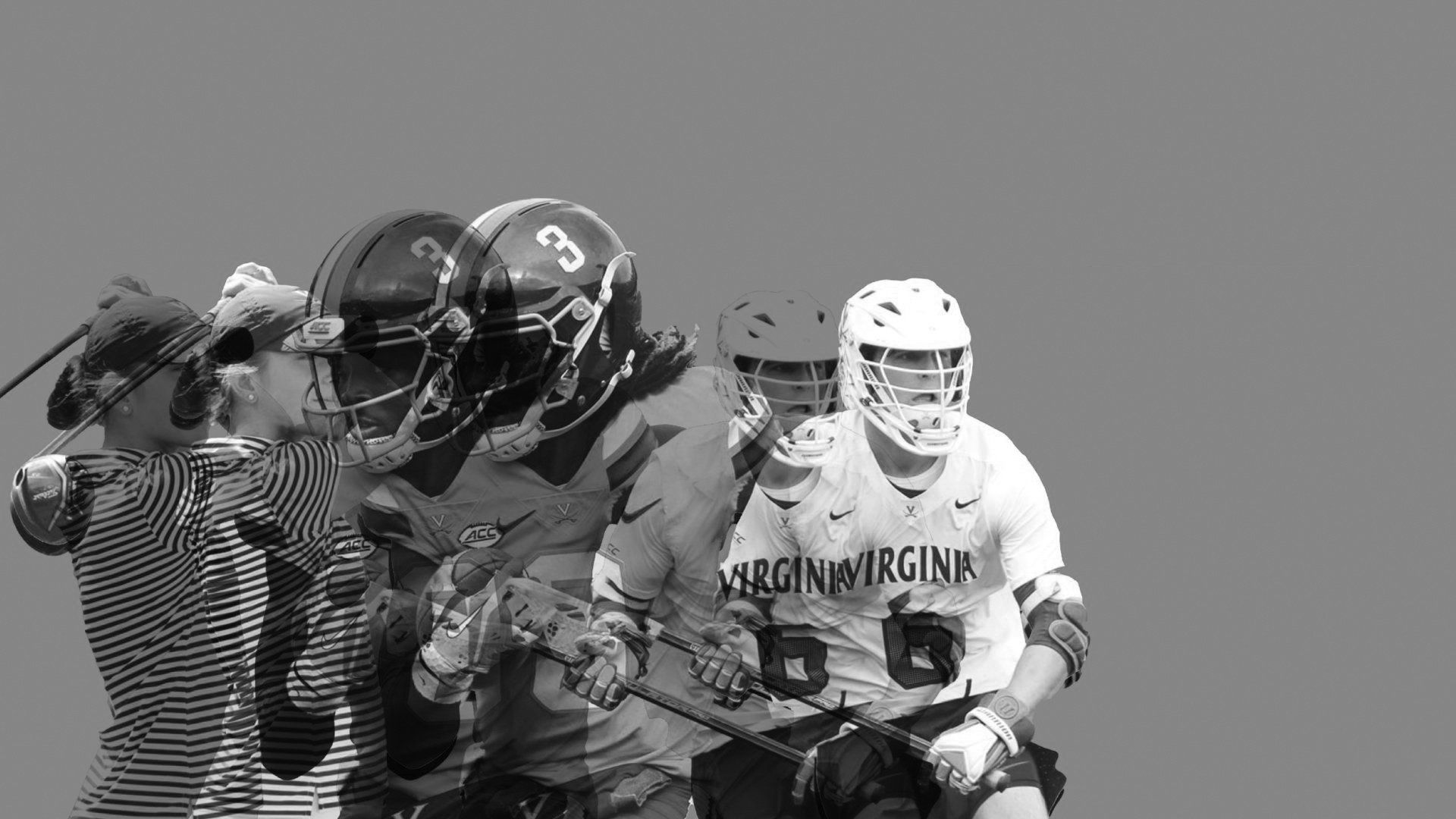
THE HERD WITH COLIN COWHERD
Trending
MLB
NFL
Gold Cup
UFL
INDYCAR
NASCAR
LIV
NBA
NHL
PGA
NCAAFB
NIL
On3 CEO addresses ex-employee’s Tennessee role
Many sports media dimensions have seen increased discussions of conflicts of interest lately. In a lot of cases, though, those conflicts have been disclosed to both employers and to the public; they can still be questioned, but viewers or readers at least are aware of them. According to On3 founder and CEO Shannon Terry, that […]

Many sports media dimensions have seen increased discussions of conflicts of interest lately. In a lot of cases, though, those conflicts have been disclosed to both employers and to the public; they can still be questioned, but viewers or readers at least are aware of them. According to On3 founder and CEO Shannon Terry, that wasn’t the case with ex-employee Grant Frerking, who was a consultant for University of Tennessee head football coach Josh Heupel while serving as On3’s president of NIL University and director of athlete network development:
On3 had no knowledge of this relationship. Grant was explicitly instructed not to engage, either directly or indirectly, with the University of Tennessee or its associated collective. On multiple occasions during his employment, he was asked to confirm compliance with this… https://t.co/6rUtzVVgSy
— Shannon Terry (@ShannonTerry) June 12, 2025
Here’s the full text of that post, which Terry put out on X Thursday in response to a Knoxville News Sentinel story from Adam Sparks on Frerking (which has since been updated to reflect Terry’s comment):
On3 had no knowledge of this relationship. Grant was explicitly instructed not to engage, either directly or indirectly, with the University of Tennessee or its associated collective. On multiple occasions during his employment, he was asked to confirm compliance with this directive, and he repeatedly denied any involvement. These representations were false. He lied to us.
The Frerking saga is notable on several levels. Frerking was a significant figure in On3’s NIL efforts, and was particularly cited as a key figure in arranging their NIL summits, involving speakers from ESPN CFB analyst Kirk Herbstreit to former LSU gymnast Livvy Dunne to chief marketing officers of Fortune 100 brands. He also often represented On3 in interviews on other media outlets.
Those media appearances included repeated appearances on SEC Network’s The Paul Finebaum Show, an appearance on Tomi Lahren’s Fox Nation show, appearances on Outkick 360 and The Athletic podcasts, and more. And while it wouldn’t have been unexpected for Frerking to have some fondness for the Volunteers considering his 2017-22 playing career with that team (he started as a walk-on, and while he only saw limited on-field action, he was cited as a member of the team’s leadership council), there’s a difference between that and serving as a paid consultant to a coach while also offering seemingly-independent commentary on that coach and program. And the latter is what’s under discussion here.
Sparks wrote that Tennessee provided the paper with documents indicating that Frerking worked for the university as a Nashville-based part-time consultant from July 2023 through this month, earning $30,000 for that role. (His contract expires as of June 30, but he no longer works for the school, and they don’t owe him any further pay.) Frerking’s duties there included “advising and consulting football coaches on best practices to navigate the current college football climate,” “assisting and advising Heupel and staff on off-field matters related to the program, both internally and externally,” “aiding in future development of program by speaking on panels and attending events (which included numerous appearances on “The Paul Finebaum Show” on SEC Network),” and more.
Frerking started with On3 almost two years earlier, in August 2021. He began work there ahead of his second-to-last season playing for Tennessee, then continued there after his playing career ended. He then worked there through May 27 of this year, leaving amidst “allegations of criminal misconduct” as per an On3 statement.
Those “allegations of criminal misconduct” are the wider issue here. Sparks and colleagues Mike Wilson and Tyler Whetstone covered a lot of that in a separate piece Thursday, which looks at how Frerking “gained fame during his playing career as the teenage CEO of what was described as a $1 million company” but “has tumbled into a mess of financial scams and legal issues that have him asking former Vols athletes for loans.”
That piece describes claims of Frerking saying he still worked at the Metro Straw ground cover company he founded while still a Tennessee player (which received a glowing writeup in The Athletic back in 2018) for years after his departure. It has accounts from people who say he used that connection (which the company disavowed in an undated online post this year, saying they parted ways with him years ago) to scam people ordering straw into making direct Venmo payments to someone associated with him and not receiving any product. There are also discussions of unpaid rent, evictions, unpaid limo fees, and more.
Those other allegations are more significant in the big picture than the discussion of Frerking working for On3 and Tennessee at the same time. And there have been many discussions of players-turned-broadcasters’ roles with their former teams over the years, from Udonis Haslem to Tom Brady to Grant Hill, David Ortiz, and Jessica Mendoza; while some of those situations (Mendoza’s in particular) have ended with the broadcasters shifting away from commentary on that sport, most have seen them continue despite ties to a former team.
But this situation goes beyond those in one crucial way: the lack of disclosure. Terry’s note here that Frerking “was explicitly prohibited” from engaging with Tennessee or its collective while working for On3, and surrounding claim that “he lied to us,” suggests he and that company were not on board with the dual role Frerking ultimately wound up with here. Beyond that, it’s certainly strange that Frerking’s role with Tennessee included “aiding in future development of program by speaking on panels and attending events (which included numerous appearances on “The Paul Finebaum Show” on SEC Network)”; the claim that Tennessee paid Frerking to appear there, presumably without that program’s knowledge, carries some questions for both sides.
That may lead to more discussions about dual roles in the college media/NIL space in particular. And those have heated up recently on other fronts, including with another situation at Ohio State drawing scrutiny earlier this year. Many of the specific details of the claims against Frerking may not be more widely relevant, but conversations about media employees also working for schools or collectives certainly are.
-

 Health1 week ago
Health1 week agoOregon track star wages legal battle against trans athlete policy after medal ceremony protest
-

 College Sports2 weeks ago
College Sports2 weeks agoIU basketball recruiting
-

 Professional Sports1 week ago
Professional Sports1 week ago'I asked Anderson privately'… UFC legend retells secret sparring session between Jon Jones …
-

 NIL3 weeks ago
NIL3 weeks ago2025 NCAA Softball Tournament Bracket: Women’s College World Series bracket, schedule set
-

 Professional Sports1 week ago
Professional Sports1 week agoUFC 316 star storms out of Media Day when asked about bitter feud with Rampage Jackson
-

 Rec Sports2 weeks ago
Rec Sports2 weeks agoScott Barker named to lead CCS basketball • SSentinel.com
-

 Rec Sports2 weeks ago
Rec Sports2 weeks agoJ.W. Craft: Investing in Community Through Sports
-

 Motorsports2 weeks ago
Motorsports2 weeks agoNASCAR Penalty Report: Charlotte Motor Speedway (May 2025)
-

 Motorsports2 weeks ago
Motorsports2 weeks agoRockingham Speedway listed for sale after NASCAR return
-

 NIL3 weeks ago
NIL3 weeks agoGreg Sankey: ‘I have people in my room asking, why are we still in the NCAA?’
































